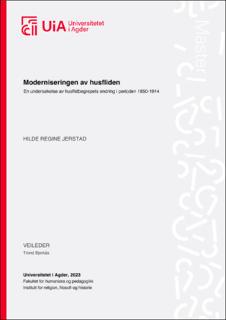| dc.description.abstract | Husflid has played a historically important role in the Norwegian culture, economy and institutionalizing of the country. In other terms, husflid is and has been a central part of Norway and its history. In different periods, separate sides of the phenomenon has been presented as being the most essential. In the early modern period, the social discourse and discussions, and the blossoming national tendencies were seen as the most relevant. Later in the 19th century, the economic aspects of husflid were seen as the most important. Today, on the other hand, the cultural aspects of husflid are viewed as the most important side of the term. The term itself has therefore changed with the times based on the impact of new impulses and modernization.
In the period between 1850-1914 a major modernization processes were in movement within the nation, which helps to explain the terms changing meaning. To map how the term husflid changed during the period 1850-1914, I have inspected three phenomena that experienced changes during the period. I started by mapping the cultural aspect, where I argued for the change of the term based on the increasing cultural and national awareness. The mapping revealed a contrived cultural heritage, based on the material husflid production. Following this, I surveyed the economic side of the term, and how changes in agriculture affected the need and production of husflid. This disclosed how the economic side of the term changed based on the general bettering of the farmers economic situation, which adjusted their previous need for traditional husflid practices. Lastly, I examined the institutionalization of Norway during the period of 1850-1914. The chapter is split in three, where I further examined the institutionalization of education, association growth and exhibitions. I started by arguing for how the term husflid changed based on the growing education in both husflid and handcrafts. I then looked at the growth of associations in Norway, and thereafter I claim, based on the source material, that the foundation of the husflid associations led to further changes in the term, this claim is even further punctuated in the last part, exhibitions, where I argued for the term’s conclusion through the anniversary exhibition at Frogner in 1914. The exhibition worked as a rendering of the term’s changes during examined the period, and the exhibition objects reflected the general public’s understanding of the term husflid at that time.
The term husflid has therefore lost its original meaning, but gained a new one, based on the different modernization processes that affected the period between 1850-1914. This entailed the social changes that further enabled changes in the term. In conclusion, the term became modernized based on the changes in culture, economy, and institutionalization. | |
